What is the deburring tumbler?
About Deburring Tumbler
- 1.What is the deburring tumbler?
- 2. What can the deburring tumbler do?
- 3.Can you tell me how the deburring tumbler works?
- 4. What are the benefits with a deburring tumbler?
- 5. What types of deburring tumbler do ShineTec have?
- 6. What does dry and wet deburring mean?
- 7.What kind of abrasive media are used in deburring tumbler?
- 8. What factors should be considered when choosing a suitable deburring tumbler?
- 9. What kind of workpiece can the deburring tumbler handle?
- 10.What are the differences between different types of deburring tumbler?
- 11.What kind of daily maintenance can extend the service life of the deburring tumbler?
- 12.How to buy a deburring tumbler?
- 13.What tips can improve the deburring efficiency of deburring tumbler?
- 14. How long does it take for a deburring tumbler to work?
- 1.What is the deburring tumbler?
- ShineTec’s automatic deburring tumbler is an automated machinery and equipment for mechanical processing, precision molds, auto parts, aerospace, medical equipment, mechanical parts, plastic products, 3C digital, metal casting, electronic devices, hardware parts, kitchenware, 3D printing, textile workpieces, powder metallurgy, electrical components, minting, jewelry, instrumentation, handicrafts and accessories and other industries, it can be used to deburr, deflash, descale, derust, etc. in large quantities and efficiently. The professional tools for surface finishing.
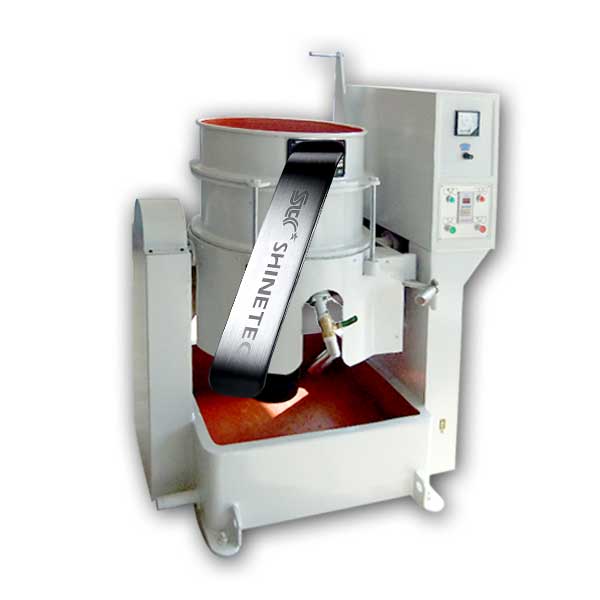
- 2. What can the deburring tumbler do?
- The automatic deburring tumbler is a specialized mechanical polishing equipment, which can be called a deburring artifact. Compared with manual deburring, this is a highly efficient automated finishing equipment that can batch hundreds or thousands of kilograms of workpieces at one time. Polishing may only take a few dozen minutes.
This kind of automated deburring machine is especially good at deburring products with irregular and complex shapes, including some cross holes, dead corners, gaps, and some hard-to-reach parts of the inner wall.
If you don’t know how to deburr your product quickly? Where can I find automatic deburring machines and equipment? The ShineTec automatic deburring tumbler introduced to you today is the best choice. In the future, you no longer need to consider manual deburring methods. Use a fully automatic deburring tumbler, right? You’ll get twice the result with half the effort.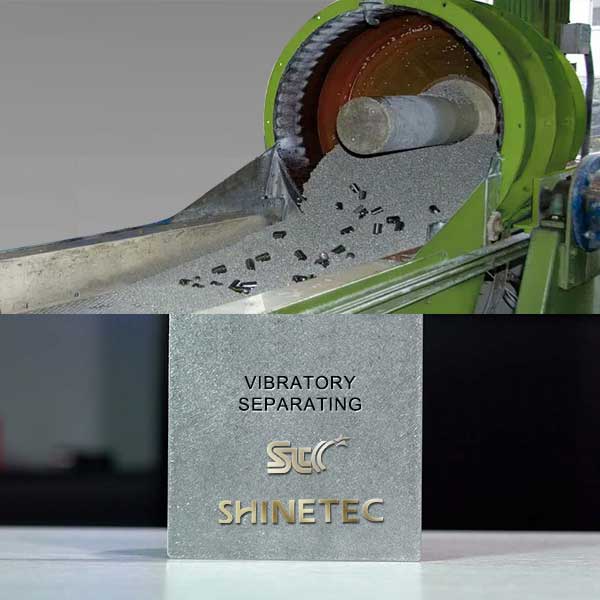
- 3.Can you tell me how the deburring tumbler works?
- In order to solve the problems of low efficiency, low quality and high labor cost of manual deburring, ShineTec’s deburring tumbler is an automatic deburring and polishing machine. The main operating principle is to combine special tumbler media with product workpieces, appropriate amounts of water and finishing compound. Mix them together in a certain proportion and put them into the working barrel of the deburring machine. Vibrating, centrifugal barrel high-speed rotating, centrifugal disc rotating, tumbling barrel rolling and other mechanical movements are used to tumble and rotate the finishing media and the workpiece together in the barrel, using the cutting force of the abrasive media surface, polish the burrs on the surface of the workpiece.
Each movement method has its own advantages and disadvantages, and is suitable for different finishing and deburring needs. Vibratory deburring is the most common process method. If you need to process large quantities every day, such as workpieces of hundreds of kilograms or more, then choose a vibrating deburring machine. If you need to process some small precision parts, the quantity is within tens of kilograms, the centrifugal barrel deburring process is the most suitable method. If you are looking for the fastest deburring process, then centrifugal disc deburring is the fastest polishing method. If you want to find the cheapest, lowest cost deburring process, go for the barrel tumbling deburring method. - 4. What are the benefits with a deburring tumbler?
- The main benefit is that this is a high-volume, high-efficiency automatic deburring process. details as follows:
4.1 Compared with manual deburring, the efficiency can be improved dozens of times. Using some large-scale deburring machines, hundreds or even thousands of kilograms of material can be fed at one time, and all can be completed within dozens of minutes or hours. Such processing efficiency cannot be compared with manual deburring.
4.2 The surface effect after deburring is uniform and controllable. The quality of manual deburring and polishing depends on the personal skill level of the worker. Some products may have clean burrs, while others may still have some residue. The surface quality of each product is different. Sometimes it may also cause product damage, resulting in a relatively high scrap rate.
4.3 The running costs of deburring tumblers are extremely low. The one-time purchase cost of the machine starts from a few thousand dollars, and it can generally be used for many years. The choice of ordinary tumbler deburring media depends on the actual conditions of the product parts that need to be processed, and the price ranges from a few dollars per kilogram to more than ten dollars. Buying a few hundred kilograms at a time can usually take several months. The amount of polishing fluid is very small and the cost is almost negligible.
Ordinary models can feed dozens of kilograms of workpieces at a time, and the deburring time for a batch is generally 30-60 minutes. The direct cost of finishing and polishing when evenly distributed to each product is minimal.
On the other hand, the advantages of automatic deburring tumbler are even greater in terms of saving labor costs. As long as workers need to handle it when loading and unloading materials, the machine can be operated unattended, which greatly saves labor costs.
4.4 In addition to the automatic deburring function, ShineTec’s deburring tumbler can also perform surface treatment processes such as descaling, derusting, deflashing, smoothing, cleaning, chamfering, degreasing, decontaminating, and improvement of surface brightness. It features powerful functions and wide applicability. If you don’t know how to quickly deburr your product, we recommend you learn more about our fully automatic deburring tumbler. - 5. What types of deburring tumbler do ShineTec have?
- According to different operating modes, our deburring tumblers are divided into the following four types:
5.1 Vibratory Deburring Machine. It is a general-purpose deburring machine. The spiral vibration method is used to drive the deburring media and the workpiece to move together to achieve the vibration deburring effect.
5.2 Centrifugal Barrel Deburring Machine. It is suitable for rapid deburring of precision parts and components. It is similar to the operation of a Ferris wheel. The motor drives the large centrifugal disk to rotate, allowing the four barrels on the disk to rotate at high speed, driving the deburring media and the workpiece to move together to achieve the centrifugal deburring effect.
5.3 Centrifugal Disc Deburring Machine. It is the fastest deburring equipment. The chassis drives the barrel to rotate at high speed on the horizontal plane. The deburring media and workpiece also tumble and rotate in the barrel to achieve the disc deburring effect.
5.4 Tumbling Barrel Deburring Machine. It is the simplest structure and the lowest cost deburring method. The barrel rolls around the central axis, and the deburring media in the barrel rolls together with the workpiece to achieve the tumbling deburring effect. - 6. What does dry and wet deburring mean?
- Dry finishing is a deburring and polishing method that only adds finishing media, workpieces, polishing paste or polishing powder when the machine is running, and does not add water.
Wet finishing is a deburring and polishing method that requires adding an appropriate amount of chemical liquid and water to the finishing media and workpiece when the machine is running.
Wet finishing is the most widely used finishing and polishing process. For most common materials and general-purpose products, wet deburring is the most suitable method. With the assistance of water and liquid finishing compound, it can speed up the deburring process, reduce bumps, lower the machine operating temperature, and avoid dust producing, extending the service life of the machine.
Dry finishing is mainly used in the polishing process of some products that cannot come into contact with water, such as the deburring process of some easily corroded metal products, wooden handicrafts, precision parts, and the drying process of products after wet finishing.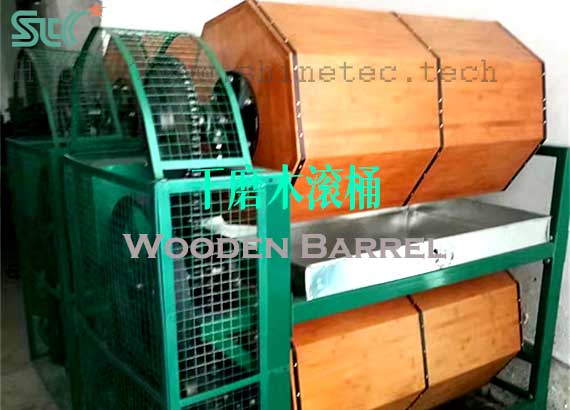
- 7.What kind of abrasive media are used in deburring tumbler?
- Because our deburring tumbler can be used to handle a variety of surface treatment process requirements, the tumbling finishing media provided are divided into three types: rough finishing, fine finishing and polishing:
7.1 Ceramic tumbling media for rough finishing, mainly include Ceramic Deburring Media, Resin Finishing Media , divided into heavy cutting force, medium cutting force and light cutting force.
7.2 Fine finishing media, include white corundum finishing media, chrome corundum finishing media, 3P finishing media, etc., because the grit size of the micropowder contained in it is very fine, some of which are nearly 2000-3000 mesh, it can continuously perform micro-cutting on the surface of the workpiece to form a more delicate surface roughness.
7.3 Tumbling polishing media include high alumina porcelain polishing media, high-density porcelain polishing media (high-alumina porcelain media with an alumina content of more than 95%), stainless steel polishing media, Walnut shell polishing media, corn cob polishing media and so on. The main purpose is to improve the gloss and brightness of the workpiece surface. - 8. What factors should be considered when choosing a suitable deburring tumbler?
- The actual surface condition of your product, such as the length of burrs, product dimensions, surface holes, gap size and distribution, product material, processing quantity requirements, and what are the subsequent processes?
Only by fully understanding your requirements can we provide the best deburring and polishing process solutions. - 9. What kind of workpiece can the deburring tumbler handle?
- No material limit. From non-ferrous metals, ferrous metals, powder metallurgy, plastics, acrylic, rubber, bamboo, stone, glass and other materials, there is almost no material that cannot be processed.
No limit on appearance. Special-shaped, irregular and complex internal and external surface shapes can be processed.
Wide range of specifications and sizes. The size of the product can range from a few millimeters to several meters. Of course, for economic reasons, the overall size should not exceed 1 meter.
Parts and components for various purposes. Metal stamping parts, laser cutting parts, aluminum alloy processing parts, zinc alloy die-casting parts, 3D printing parts, plastic injection molding parts, etc. If you are looking for a automatic deburring machine, metal deburring machine, precision parts deburring machine, mechanical parts deburring machine, plastic product deburring machine, laser cutting deburring machine, gear deburring machine, ShineTec’s deburring tumbler is sure to meet your needs.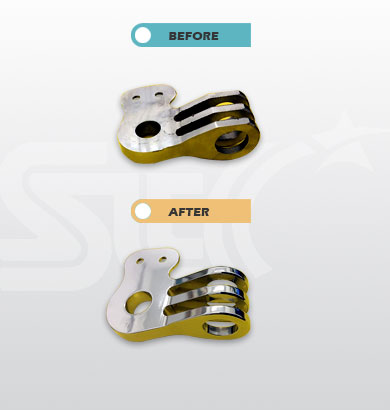
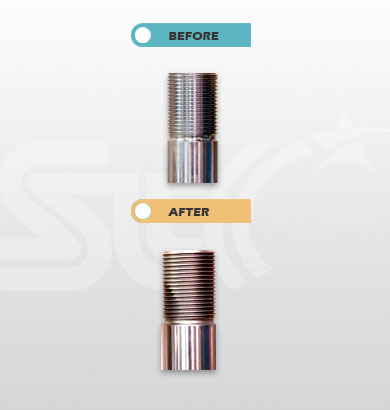
- 10.What are the differences between different types of deburring tumbler?
- Let’s compare the differences between different types of automatic deburring tumblers from the following aspects:
10.1 Processing capability. We compare according to the largest models in their respective categories. The vibrating deburring machine can process tons of products at a time. The largest barrel deburring machine can also achieve such processing capabilities. The centrifugal disc deburring machine can reach 1-200 kg, the centrifugal barrel deburring machine can handle about 2-300 kg. Taking into account the processing time required for a complete batch, the processing capacity can be arranged in the following order: vibratory finisher > tumbling barrel finisher > centrifugal barrel finisher > centrifugal disc finisher.
10.2 Machine noise. vibratory tumbler > centrifugal disc tumbler > centrifugal barrel tumbler > tumbling barrel tumbler.
10.3 Deburring time. centrifugal disc tumbler > centrifugal barrel tumbler > vibratory tumbler > tumbling barrel tumbler.
10.4 Deburring cost. centrifugal disc tumbler > centrifugal barrel tumbler > vibratory tumbler > tumbling barrel tumbler.
10.5 Cutting force. centrifugal disc tumbler > centrifugal barrel tumbler > tumbling barrel tumbler > vibratory tumbler. - 11.What kind of daily maintenance can extend the service life of the deburring tumbler?
- 11.1 Do not overload the machine. Each automatic deburring tumbler has a rated usage capacity, so the machine cannot be overloaded in order to improve production efficiency. Generally, the material loading capacity of the entire machine should not exceed 70% of the total load capacity of the machine.
11.2 Maintain regular maintenance. The specific work content involves the lubrication of the motor, inspection of the PU lining, inspection of the integrity of mechanical components, inspection of operating temperature, etc.
11.3 Inspection of electrical systems. Check whether the components in the electrical control box are aging, and whether the power cord is broken or the copper wire is exposed. - 12.How to buy a deburring tumbler?
- We are a manufacturer of deburring tumbler. Before ordering, you need to send samples for process testing. If you are satisfied with the results, please refer to the following steps to confirm your ordering requirements:
12.1 Power requirements. Our parts deburring machine requires 380V/3-phase/50Hz industrial power and is not suitable for civilian 220V/2-phase power. Special requests need to be confirmed in advance.
12.2 Processing capability requirements. First estimate the quantity of your product that needs to be processed every day, your shift schedule, and confirm the machine model based on the process plan.
12.3 Your product parts size. The workpiece within 300mm can be processed by all models, but the vibrating finisher is the most commonly used deburring equipment. For workpieces that are too long, a rectangular tub deburring machine is needed. Some small-sized precision parts require the use of a centrifugal barrel finisher. For workpieces within 100mm that need to be quickly deburred, a centrifugal disc finisher is the best choice. No afraid of deformation or bumping. Use a barrel tumbling finisher for thin workpieces within 300mm in length that are easy to adsorb to each other.
12.3 Selection of deburring media. According to the effect of the sample, select the appropriate abrasive media, cutting strength, shape, and size.
12.4 Durability of tumbling media. Different cutting strength, shape, and size determine the different wear resistance properties of abrasive media when used. Tumbling media with heavy cutting force have smaller wear resistance than media with light cutting force due to the large grit size of corundum sand contained. The larger the product, the longer it will last and the more wear-resistant it will be. There are also different shapes with different wear resistance. For example, shapes such as spheres and cylinders are more durable than triangles and tri-star shapes.
12.5 Finishing time. The deburring efficiency of each model is different. You should choose the appropriate model based on your production shift schedule, product output, and batch processing time requirements for finishing and polishing.
12.6 The working intensity. The bowl of the vibrating deburring machine is open, making it easy to load materials; the centrifugal disc type is similar and easy to load and unload; the centrifugal barrel type has a smaller working barrel and a smaller opening, so it takes more time to load and unload. The opening of the tumbling barrel is also small, and the loading and unloading of materials is relatively slow; the overall labor intensity and loading and unloading time are stronger than the centrifugal disc/barrel type. - 13.What tips can improve the deburring efficiency of deburring tumbler?
- Some precautions during actual use can help improve the efficiency of the automatic deburring and polishing machine.
13.1 Reasonable ratio of abrasive media to workpiece. The reasonable ratio of the two when loading and feeding is the key factor affecting the finishing and polishing efficiency. The most commonly used ratio is 3:1 abrasive to workpiece. Please refer to the table below to determine your usage:Abrasive media to workpiece volume ratio Typical application 0 : 1 No tumbling media, self-finishing and polishing, such as some decorative stones for handicrafts. 1 : 1 The same proportion of abrasive media and parts such as forgings, castings, etc., with very rough surfaces. 2 : 1 Gentle finishing, allowing workpieces to collide with each other. 3 : 1 Minimum ratio for finishing copper, aluminum, zinc and other non-ferrous metal workpieces. The workpieces may collide with each other, so the ratio is suitable for grinding and polishing ferrous metals. 4 : 1 The ratio of non-ferrous metal workpieces with average efficiency. High polishing efficiency ratio for ferrous metal parts. 5 : 1 More suitable for finishing non-ferrous metal parts. Workpieces rarely collide with each other. 6 : 1 Suitable for finishing of non-ferrous metal products. Commonly used for pre-plating treatment with resin media and aluminum and zinc alloy workpieces. 8 : 1 Suitable for finishing of non-ferrous metals or precision parts. Less surface roughness and smoothness. 10:1~20:1 Better finishing quality. Suitable for irregular shapes or fragile workpieces. Maximizing No collision between workpieces. One machine polishes one part or each workpiece needs to be separated. 13.2 Loading capacity. Too much or too little loading will affect the finishing efficiency of the machine. Please do not feed materials at 100% full load or less than 50%. Generally, the overall volume of the material after loading does not exceed 70% of the barrel volume, and the water surface does not exceed 80% of the barrel volume.
13.3 Amount of finishing compound liquid. Too little dosage will definitely not play the role of the additive in accelerating grinding. Too much dosage will produce a large amount of foam, which will pollute the environment, and on the other hand, it will block the tumbling and rotating motion of the abrasive media and the workpiece, reducing the grinding efficiency.
13.4 Suitable machine operating speed. This is a process that requires long-term experience accumulation. Polishing efficiency depends on the material and size of the tumbling media used, the amount of water and chemical finishing liquid added, and the running speed of the machine. Too little material input and high-speed machine operation speed will cause over-grinding of the product, affecting the overall size, accuracy or chamfering degree. Excessive material input and too low machine speed will cause insufficient movement of the workpiece inside the abrasive media, reduce cutting strength, and affect efficiency. - 14. How long does it take for a deburring tumbler to work?
- It depends on the specifics of your product. Generally speaking, soft metals such as aluminum alloys and zinc alloys can achieve a satisfactory effect in less than an hour, while hard product workpieces such as stainless steel, titanium alloys, and cemented carbide may require Requires more than 2 hours of deburring time.
In addition, the size of the machine used also affects the processing time. The bigger the machine, the less time it takes to grind.